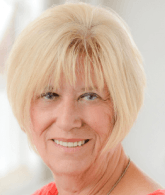One on one with… Chelley Antonczak
In a busy office, surrounded by colorful tote bags filled with treats, crayons, flip charts and other materials, including reading, writing and arithmetic exercises, Long-Term Living Managing Editor Sandra Hoban sat down with Chelley (Michelle) Antonczak, network director of training for SAIDO Learning at Eliza Jennings Senior Care Network, this year’s OPTIMA Award winner. Antonczak traveled to Japan to see the dementia care program in action and helped to make it a reality at the Eliza Jennings Senior Care Network.
How did you become involved in the SAIDO Learning project?
I previously worked in staff development and helped out researching SAIDO in 2010–2011. When Eliza Jennings President/CEO Deborah Hiller decided to pursue the SAIDO Learning method of drug-free dementia care, I was part of the team that traveled to Japan to train under the guidance of Dr. Ryuta Kawashima of the Smart Aging International Research Center and the Kumon Institute of Education.
Although we had to make some adaptations to make the program usable in the United States, we did preserve the integrity of the Japanese Kumon method in our implementation of SAIDO Learning in our three Ohio facilities: Eliza Jennings in Lakewood, the Renaissance in Olmsted Township and Devon Oaks in Westlake.
What challenges did you overcome to establish SAIDO in your communities?
The original materials—the reading, writing and arithmetic exercises—were, of course, geared to the Japanese culture. It was necessary to convert these materials so that they reflect American culture and language. We also had a Japanese trainer come to Cleveland to ensure that the program was implemented correctly.
We trained staff volunteers who were interested in supporting this endeavor to become “supporters.” They learn how to encourage and engage the residents with dementia, known as “learners.” Working together, they build relationships and confidence and bask in the glow of success as learners achieve their individual goals.
We provide daylong training at various locations in the Eliza Jennings Senior Care Network. As time has passed, however, we are also training family members and volunteers from the community at large who are interested in becoming supporters.
What makes SAIDO Learning such a unique and effective program for residents with dementia?
Most important is that every learner is successful. Residents are evaluated and given exercises compatible with their level of cognition. There are no failures; everyone succeeds. Supporters provide continual, sincere encouragement as learners work through their exercises or activities, such as matching numbered disks to the same numbers printed on a mat.
Continuous positive reinforcement encourages the learners to stay engaged in whatever project they are involved with at the time. At Eliza Jennings, we’ve seen how [five-day-a-week] 30-minute sessions keep residents calmer and more social, which contribute to an improved quality of life. Families notice the difference. The most gratifying moments are when families reconnect with their loved ones. When families visit, either in person or by phone, they are happy that their mom or dad may be able to recognize them and communicate on a more satisfying level. Because of the progress the residents have made in stemming their dementia or improving their memory and conversation through SAIDO Learning, many are able to resume favorite activities and even leave the facility for a family outing.
What feedback have you received from the participants in SAIDO Learning?
SAIDO supporter Bobbie Porter, a medical billing specialist, has said how gratifying and fulfilling it is when her learners achieve a goal, regain a memory or simply enjoy one another’s company. This feeling is universal among the supporters. We build a great rapport, and once a resident becomes accustomed to the sessions, everyone has a good, productive time together. Supporters feel that mornings are the best times to hold sessions because residents are rested. However, SAIDO Learning can be fruitful whenever the resident is ready to participate.
Through their individual successes, learners continue to progress through the arithmetic, reading and writing exercises. Nothing motivates more than seeing a program work. Watching residents with dementia come back to life and begin communicating more and wanting to take care of themselves is a source of motivation for supporters and a sense of triumph for learners. SAIDO learners share their excitement with other residents. Many become buddies and look forward to sessions together.
What does the future hold for SAIDO Learning in the United States?
We recently became a licensee of SAIDO Learning and are establishing a SAIDO training center to show other organizations how to implement this proven rehabilitation method in their facilities. We are planning to have an additional outreach program where we go directly to interested facilities to help train and implement the program. We’ve been getting a lot of inquiries about SAIDO Learning. Participants range from staff to family members to interested community volunteers—all interested in giving their time in a special way.
More OPTIMA Award coverage:
The gift of the present
How SAIDO Learning works
The SAIDO clinical trial
SAIDO Learning: A timeline
SAIDO Learning in action: A typical session [VIDEO]
Blog: The elusive high five
SAIDO Learning: Seeing is believing [PODCAST]
SAIDO Learning: 'It's remarkable' [PODCAST]

Sandra Hoban was on I Advance Senior Care / Long-Term Living’s editorial staff for 17 years. She is one of the country’s longest-serving senior care journalists. Before joining Long-Term Living, she was a member of the promotions department at Advanstar Communications. In addition to her editorial experience, Sandi has served past roles in print and broadcast advertising as a traffic and talent coordinator.
Related Articles
Topics: Activities , Alzheimer's/Dementia , Articles , Executive Leadership , Leadership











